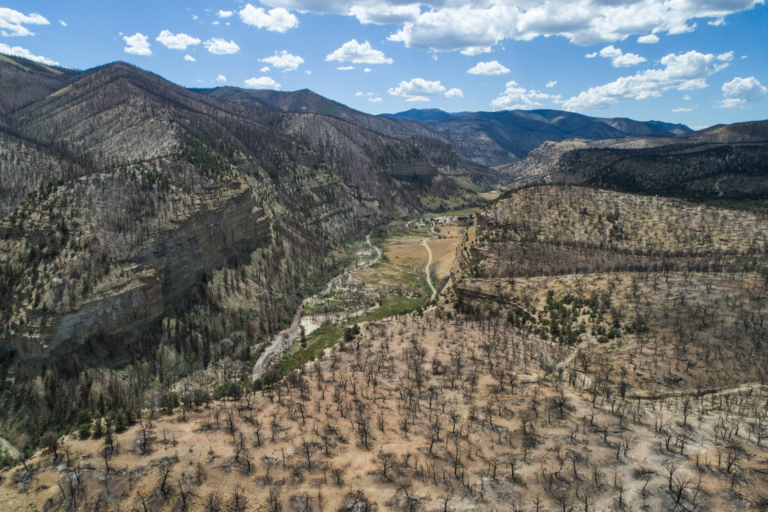When a River Burns
Of forests, fire and fish.
It was early July 2018 and the cottonwoods along the Strawberry River in northeastern Utah were charred skeletons. We drove through them in silence, noting not just the trees but the blackened swing sets, cars and concrete foundations of homes and cabins that had burned a few hours prior. We rounded a corner and came upon the remains of a drift boat on a trailer, its tires melted, the frame of the boat the same shade of black as the dirt surrounding it.
I was a member of a 20-person fire crew that was assigned to the Dollar Ridge Fire near Duchesne. Despite our best efforts, the fire ravaged the canyon, burning the cottonwoods, willows and virtually everything green—the river’s once-lush banks turned unrecognizable. By the end of our assignment there, the fire, which was human-caused, had burned nearly 69,000 acres and 74 homes.
As we worked that day in the canyon, I couldn’t help but steal glances at the Strawberry, from which we pumped water to power a line of sprinklers. This “wet line” was our last-ditch effort to slow the fire’s progress as it navigated the river’s canyon. After setting up a pump to bring water to the sprinklers, we quickly splashed the river’s water on our faces and necks, rubbing away the dirt, ash and sweat that had built up during our work.
“Hey, 15 minutes and we gotta go,” the voice of a supervisor bellowed from the radio, barely distinguishable over the deep groan of the pump. “Get as many sprinklers in as you can and get back to the buggies—fire’s close.”
I ran up the bank, taking one final look at the river, its water running clear and low. As the only crew working in the canyon that day, we’d had under two hours to do everything we possibly could to protect the river and the homes on its banks.
Prior to the Dollar Ridge Fire, the Strawberry—a tailwater fishery with a handful of free-flowing tributaries—was home to a healthy population of brown and rainbow trout, alongside a smaller population of Colorado River cutthroat trout. In an April 2018 (pre-fire) survey of the stretches of the river most frequented by anglers, the Utah Division of Wildlife Resources found trout populations to be at their highest levels since they began managing and surveying the river in the 1970s. But fish surveys taken in the fall of 2018, five months after the fire, produced no fish in the section of the Strawberry affected by the fire.
“In my whole career, this is the biggest fire I’ve seen [in this watershed] and really the only one that impacted cutthroat trout at this magnitude,” said Ron Brunson, a fisheries biologist with nearby Ashley National Forest.
The vast majority of damage to the river wasn’t caused solely by the fire, but by the historic rain events that occurred in its immediate aftermath. Although the rain seemed to be an asset at the time—helping us wrap the rest of the fire perimeter outside the Strawberry River area—it also produced mudslides that resulted in considerable damage to the river, access roads and the few cabins and homes that hadn’t been affected by the fire itself.
While significant rainfall was at fault for a majority of the damage to the Strawberry River, fires of similar intensities in different ecosystems—namely, those that are densely wooded, drought-ridden or haven’t burned in decades—would likely result in a “stand- replacing” fire, much like what happened in the Yellowstone Fire in 1988. These so-called megafires are historically rare but growing more prevalent, resulting from a myriad of issues and shortsighted forest-management practices. Such practices, which include not allowing fire into landscapes that have relied on it for millennia, have produced forests that haven’t burned in decades and are therefore drought-affected, bug-ridden, choked with brush and hugely susceptible to large, high-intensity fires.
“The West loves to burn, it’s prone to burning and it’s going to be even more prone to burning with climate change,” said Patrick Belmont, associate professor of watershed sciences at Utah State University. “We were really successful in suppressing fires for decades, but at this point, fires are out of control almost from the point of ignition.”
High-severity fires can destroy everything from the nutrient-loaded duff layer to mature stands of trees that have spent dozens or even hundreds of years coexisting with fire. Without this intricate web of vegetation and roots to hold the soil together, rainstorms push massive amounts of debris into watersheds, often resulting in either too much phosphorus (which can choke a river with algae growth) or loss of oxygen due to excessive sediment. Either circumstance can result in massive fish die-offs. This loss of forest canopy also results in higher water temperatures and less cover for fish, particularly in rivers that can’t self-regulate temperature through groundwater. As forest mismanagement, climate change and other factors combine to contribute to more extreme wildfires, more watersheds will be susceptible to destruction.
“There needs to be a pretty major shift in strategy for how we manage our forest fires, which will necessarily involve a lot of fuel reduction and prescribed burning,” Belmont said. “We just can’t continue to suppress them; we need to fundamentally shift our strategy towards managing forests and fires.”
That fundamental shift will mean a reckoning with one indispensable fact: Wildfires are essential for forest health. In many ecosystems, low- or moderate-intensity fires occurring on a three-to-10-year cycle serve a vital role in the health of a forest, which is why regular prescribed burning—or introducing fire to forests in a controlled manner to clear underbrush and prevent or hinder future fire spread—is one of the most useful tools firefighters have. Fire is equally critical for rivers, as it introduces nitrogen and phosphorus to riverbanks and to the water itself, promoting algae and aquatic insect growth while creating fish habitat by weakening trees that will eventually fall into the river, providing shade and solace to holding trout.

The Dollar Ridge Fire started on July 1, 2018. By the time it was over, in October of that year, the fire had consumed more than 68,000 acres, including this section of the Strawberry River. Photo: Photo: Andrew Burr
The only way to prevent megafires is to strive toward a mutually beneficial coexistence with fire right now; this will require a full-scale cultural shift that moves us away from fearing fire and toward using it to our advantage. Providing the funding and resources for regular prescribed burning in the cooler, wetter non-fire seasons—when conditions are mild and less likely to produce intense fire behavior—is the biggest step fire managers can take to prevent large-scale, high-intensity fires from affecting the rivers and forests we love. Additionally, putting federal firefighters—many of whom are seasonal employees who become unemployed in the off-season—to work doing prescribed burning and thinning projects through the fall, winter and spring would mean more work for us in the winters and less potential for severe fire spread in the summers. Funding federal employees and firefighters to do meaningful prevention work in November or March will ultimately cost less than having them continue to attempt to suppress fires in August.
Rivers are resilient things, and the trout that reside in them are equally tough—they’ve spent millennia adapting alongside fire and will continue to thrive so long as fires continue to burn in the regular, low-intensity intervals that was the historical norm. And as our environment continues to evolve before us and despite us, we could stand to learn a thing or two from trout in this regard; building our own resilience to fire will be critically important moving forward, not just for us, our communities and the forests we love, but for the rivers and, ultimately, for the trout that call them home.

